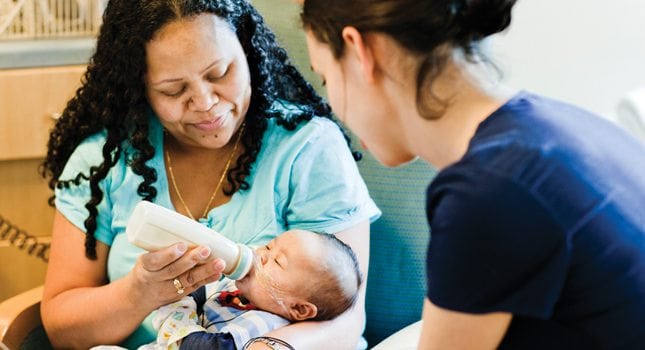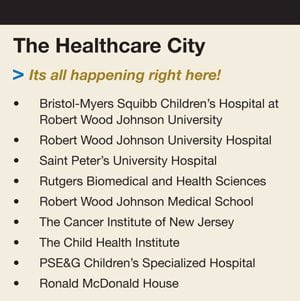
Little Patients, Big Medicine
New Brunswick’s Leadership Role In Pediatric Care
By Brenda Considine On May 28, 2014A baby is born months early. Weighing just a pound, eyes fused closed, and fitting into his father’s hand, the tiny boy’s lungs are undeveloped.
A merit scholar with plans for the Ivy League is paralyzed when the car he is driving is struck by a drunk driver.
A bright-eyed toddler flops to the floor in a tantrum. His mother worries that the boy is still not speaking and prefers to play alone.
A nine-year old with colorful barrettes holding her black braids is diagnosed with a rare and life-threatening form of leukemia.
A teen with a complex spinal deformity learns that he will need yet another surgery, followed by months of rehabilitative services and therapies.
What do these children and their families share? They all found hope at the region’s best pediatric medical facilities – the Children’s Academic Health Campus in New Brunswick.
“If you look at the great centers of medicine, it is understood that the best of healthcare is almost always accompanied by the best of research and the best of teaching,” said Arnold B. Rabson, MD, professor of Pediatrics at Rutgers-Robert Wood Johnson Medical School, and director of the Child Health Institute of New Jersey (CHINJ). “Those are the ingredients we have in New Brunswick.”
“The Healthcare City”

“People tend to look to our big city neighbors – New York and Philadelphia – but it is all happening right here,” said Christopher Paladino, president of New Brunswick Development Corporation (DEVCO). Founded in the mid-1970’s, DEVCO has overseen nearly $2 billion in investment aid in New Brunswick’s economic revitalization and has helped direct the city’s dramatic renaissance.
Dubbed “The Healthcare City,” New Brunswick is home to the country’s largest medical school, two world-class teaching hospitals, and internationally recognized medical research facilities. The roots of the city’s investment in healthcare can be traced to the early days of revitalization, when Johnson & Johnson made the decision to recommit to New Brunswick by building their worldwide headquarters in the city, launching the first of many long-term public-private partnerships.
According to New Brunswick Mayor Jim Cahill, it was that commitment that allowed the city to demonstrate its strong foundation and track record of success.
Facing a recession in the 1990’s, city leaders realized that two decades of redevelopment could come to a grinding halt. “We needed to establish a “recession-proof” platform for continued development. We brought city leaders together and committed to use resources to develop the concept of “The Healthcare City,” Cahill explained. “It was not only to help with marketing, but also, a statement of fact: the best quality of care in the region could be found right here.”
Partnerships In Action
The city’s promise of the best in healthcare in the region extends to the youngest patients.
In the heart of downtown New Brunswick, the Children’s Academic Health Campus invites collaboration and innovation. Comprised of The Bristol-Myers Squibb Children’s Hospital at Robert Wood Johnson University, PSE&G Children’s Specialized Hospital and The Child Health Institute of New Jersey, the academic campus covers a full city block, and is literally centered around a colorful playground.
“The Campus brings together surgeons, rehabilitation experts, academics and researchers to deliver the best in coordinated pediatric care to the kids of New Jersey,” said Joseph Barone, MD, surgeon-in-chief at The Bristol-Myers Squibb Children’s Hospital at RWJ University Hospital, and professor and chief of the Division of Urology. “It allows us to harness our collective resources to provide better, more comprehensive care for our patients.”
In addition to the direct benefits to young patients and their families, Mansue believes that the research capabilities of the campus are vital for effective planning and developing the best public policy.
“We have a responsibility to participate in research that proves the efficacy of the work we do, not only so others can benefit, but also to show policy makers that what we are doing works. We need to do all we can to help to ensure that the care that is most important for children with complex health care needs is also covered by insurance.”
The combined resources at the Campus also make it a strong contender for research dollars. With the merger of Rutgers University and UMDNJ in 2013, New Jersey is now well positioned to capture National Institutes of Health (NIH) research funding. According to Congressman Frank Pallone, a member of the House Energy and Commerce Committee’s Subcommittee on Health, Rutgers now ranks among the top 25 research universities in the country, with more research spending than top-rated competing universities.
Mansue believes that funding for research in New Brunswick will only continue to grow.
“The top children’s hospitals share four elements,” she said. “They are located on an academic campus; there is an acute care service; they provide high quality rehabilitation services; and there is research being done that links the latest science and technology to the bedside. The only place this exists in New Jersey is in New Brunswick.”
The Best and the Brightest
New Brunswick has become a magnet for the next generation of leaders in healthcare.
“The resources in this city allow us to recruit and retain international scientists, physicians and educators to benefit not only the residents of New Brunswick, but also the people of New Jersey and beyond,” said Dr. Rabson.
Case in point: The Bristol-Myers Squibb Children’s Hospital at RWJ University Hospital recently recruited two very skilled doctors: one from Johns Hopkins in Baltimore, and another from Texas Children’s Hospital in Houston. According to Dr. Barone, these young medical leaders will be working to develop a special program for children with hearing loss.
“They could have gone anywhere in the world. They chose to come here because they saw something compelling and unique. Here, they will have a free standing research building as part of our campus, with 10 Ph.D.’s doing funded research in leukemia, autism asthma, and diabetes – it is very attractive to these young doctors,” added Dr. Barone.
“New Brunswick is home to some of the smartest people in medicine because they want to be here, to partner with the best for the cures of the future. They want to be on the ground, making a difference,” said Mansue.
One only needs to look to the credentials of Dr. Rabson to see how New Brunswick retains world-class leaders. He holds undergraduate and medical degrees from Brown University and residency training at the Brigham and Women’s Hospital at Harvard Medical School. Prior to coming to Rutgers/RWJ Medical School 24 years ago as a resident member of The Center for Advanced Biotechnology and Medicine, Rabson worked at National Institutes of Health (NIH).
“The chance to work with someone like Arnold Rabson is part of what makes this so exciting,” added Mansue. “He is one of the most revered scientists in the country.”
“The energy and enthusiasm of the faculty here is unparalleled. I feel like my contributions can make life better, both in academics and in medicine and for the children and their families in this community,” said Dr. Rabson, who credits DEVCO and Mayor Cahill for setting the stage for collaborative initiatives.
Moving from the Bench to the Bedside
From lupus, to kidney disease to autism, practitioners and researchers working together are bringing tomorrow’s treatments and technologies to today’s patients.
Consider the work of pediatric nephrologist Dr. Sevgi Gurkan, a member of the Department of Pediatrics at RWJMS and a resident scientist at the Child Health Institute of New Jersey. She found that a common form of kidney disease in children is due to an immune response of the kidney cells, often associated with allergy, eczema or recent infections.
“She has worked with the Pediatric Clinical Research Center and the Bristol-Myers Squibb Children’s Hospital to bring clinical trials of new biological therapies to children who have relapsed kidney disease that is resistant to standard therapies,” said Dr. Rabson.
At PSE&G Children’s Specialized Hospital, technology is allowing doctors to provide direct care, even when they are not in the building.
“We have a robot in the unit that allows our physicians to dial in for bedside access to their patients during hours when they cannot physically be here,” said Mansue. “It gives them critical contact and ensures continuity of care for children with complex conditions.”
Legacy Ahead
The collaborative partnerships have ripple effects that are bringing innovation to children and physicians across the state.
Children’s Specialized Hospital, under a grant from the Governor’s Council on Autism, developed – and is now testing – a tool to help the layperson determine if a child is at risk for autism.
“New Jersey has the highest rate of autism in the country, but the average age of diagnosis is 7½,” said Mansue. “This tool will help parents and physicians, especially those in underserved communities, identify children at an earlier age, when intervention is so critical.”
“We could not have created this tool without the help of the researchers and scientists on the campus,” said Mansue. “This has the potential to help tens of thousands of children, today and in the future.”
Because of the city’s well-established infrastructure around pediatric health care, Dr. Rabson believes New Brunswick could easily be home to the next big medical discovery, treatment or cure.
Mansue agrees. “I think this will be the place that the research will happen.”
“We get only one chance to make a difference in the life of a child,” concluded Mansue. “Thanks to these partnerships, we have the opportunity to make our work the best it can be, and to share it with others – that is a pretty powerful thing!”



